Since early December 2001, I have been flying a new wing - the
Independence Dragon. Below is my attempt at a review of this great
wing. Please understand that I am NOT a professional pilot, or big-shot paragliding sky-god. Also, since I own this
wing, please don't expect me to say too many negative things about a
product that I shelled out my own money for.
I purchased this wing from the US distributor; Southern
Skies and I must say that Chris and Tammie Bowles are about
the nicest people you could ever hope to meet. If you read this
review and are interested in this wing, please contact Chris so that
he can arrange a demo, either through Southern Skies, or one of the
other local dealers he supplies wings. You won't be disappointed.
About my background - I have been flying PG for about 3 years
now, PPG for 2.5 and I've mostly stuck with DHV 1 wings. Most of my
time is on a DHV 1-2 Edel Atlas, which is only a 1-2 when
accelerated. I consider myself a fledging intermediate pilot and
stepping up to one of the newer 'hot' DHV 1-2's was my goal. I
narrowed the choice down to three wings, demoed two of them, not
bothering with the third after trying the Dragon. I really like this
wing, but I'll try to be objective and not too enthusiastic about
it. :)
Now, on the the review:
Manufacturer: Independence
Gliders is a new company out of Germany and they released the first
Dragons in Europe back in August. These wings are now making their
way across the pond. The founder of Independence and chief designer
is Michael Nesler, who formerly designed wings for Edel and
Firebird. He also develops paraglider design software that is widely
used in the industry. The Dragon is the first wing that this new
company has introduced to the market. The Independence Gliders
website can be found at: www.independence-world.de
The Dragon is Independence's entry into the red-hot DHV 1-2
intermediate wing market. With each major paragliding company
introducing a new DHV 1-2 wing over the past 6 months, this is an
exciting marketplace for consumers. With each new design or
innovation, the bar is raised for the next wing and this competition
has resulted in a batch of high quality, high performance wings that
offer the safety of a DHV 1-2 rating. The Dragon is no different,
comparing favorably in performance to other new designs in this
class.
Wing Parameters for the Dragon are listed below:
You can get more detailed info about the Dragon (and many other
wings) at the Para2000.org
website.
Construction and Materials:
Fabric: The fabric on the Dragon is Porcher Marine Skytex
E77 with silicon coating. This fabric weighs 44-grams/square meter
and is used on both the top and bottom sail. When I first pulled it
out of the bag, the first thought that can to mind was ‘Crispy!”
Lines: The lines are made from Edelrid Aramid (non
stretching Kevlar) the lower lines are 1.5 and 1.8 mm thick. There
is only one line junction, resulting in only upper and lower lines,
no intermediate lines. This, coupled with the fact there is a line
only at every other cell makes the line layout very clean.
Risers: The standard riser system consists of a 4 riser
system with split A’s. Top A risers are the inner lines while the
second a riser is connected to the outer a line. There are 4 B
lines, 4 C lines and 3 D lines. Motor risers are also available,
with the same configuration, only short and with a trimmer system.
The motor riser equipped dragon is now undergoing DULV certification
in Germany and the risers on that version include trim tabs.
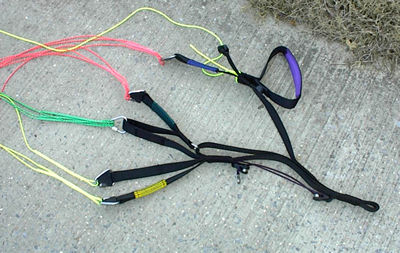
Riser and Brake Configuration
The risers are black, with colored fabric sewn into the riser for
identification. Each set of lines is a different color, which is a
nice feature. The only complaint is that the stabilo line (outer
most B-line in the case of the Dragon) is the same color as the
other B-lines. This could make identification of the stabilo in the
air more difficult, if the pilot ever needed to pull a stabilo to
recover from a cravet.
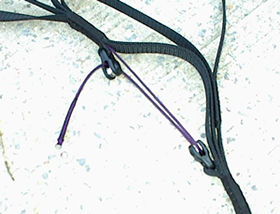
Dragon speed pulleys
Brake Toggles: The brake toggles are firm nylon with soft
padding inserted, making them very comfortable. The toggles are held
to the riser with magnetic clips. These clips work reasonably well,
although the magnets could be stronger. The magnets on the riser are
inset slightly and the brake side acts like a small button, or plug,
fitting snugly in the riser side magnet. I fly in an area with high
iron content in the soil and magnetic brake clips have always been
problematic due to the attraction of small iron particles to the
magnets. Independence solved this problem by coating both magnets
with a thin rubber coating. This makes removing the iron dust from
the magnets as simple as wiping them away with your fingers. Chris
Bowles tells me that Independence has since switch to standard
button snap brake attachments.
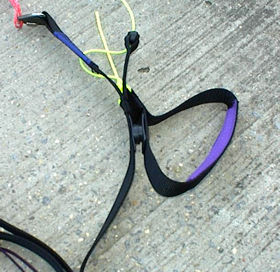
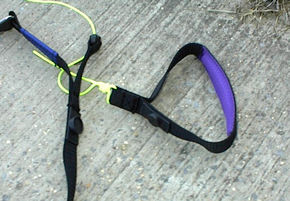
The Dragon's magnetic brake
toggles
Cells and Line Attachments: The medium has 42
cells and the line attachments are at every other cell with diagonal
internal cross braces sewn into the interior of the wing. The center
two cells do not have cross bracing, which give the wing a natural
hinge point for more effective weight-shift control. As stated
above, there are only upper and lower lines on the wing.
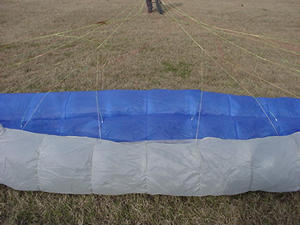
Line attachments on the Dragon
Flight Characteristics:
Launch: Launching the Dragon is very
straightforward. The wing comes up fast and does have a slight
tendency to overshoot when pulling up in high winds. This is easily
corrected with brakes, or by using the both the A's and B's during
pull-up. There is no hard-point in the pull-up – the glider
smoothly comes up overhead. After pull-up, the glider is very stable
overhead, responding the small pilot inputs when necessary.
Independence recommends using just the inside A’s for pull-up, and
I agree that this technique works well for both for forward and
reverse launches. Holding both the inner and outer A’s during pull
up does lesson the tendency of the wing to overshoot, but it also
allows the tips to come up before the center of the wing, requiring
good kiting skills to manage.
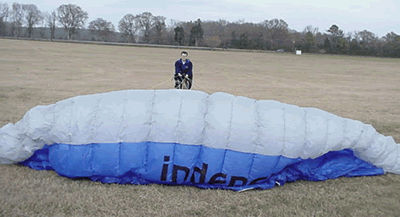
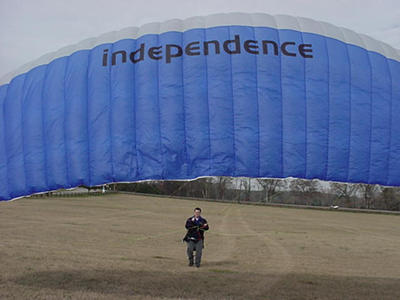
Pulling up the wing in a light
breeze
Another reviewer noted that the wing has strong
tendency to untwist risers following a reverse inflation. I noticed
this as well, but only on my free flight harness, when I had the
carabineers set considerably far apart (> 50 cm). I typically fly
with my biners at 44cm distance (as this is the distance that the
DHV tests gliders) but often increase the distance when kiting. I
did not notice a tendency to untwist with flying with my SkyCrusier,
but the riser attachments on the SC harness are fairly close
together, and much higher than on my Sup-Air paragliding harness.
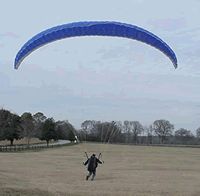
Forward kiting
No wind launches are very easy with the Dragon. I
haven’t missed a forward with it yet, and it also allows the use
of the no-wind running reverse technique. While initially kiting
then wing, I was able to bring it completely overheard with a
running reverse, without ever touching the risers.
In-Flight: This is a fun glider to fly. It has the safety of
a DHV 1-2 wing, but also a level of performance that I have not
experienced before. The top speed of the wing is impressive, but
what is more impressive is that they were able to increase the speed
of the wing, while keeping the trim speed at 37 km/hr. This speed
range makes it a very fun glider to fly; you can go slow and enjoy
the scenery or milk the available lift, but if you need to penetrate
in high winds or outrun some nasty sink you have the available top
end just a speed bar away.
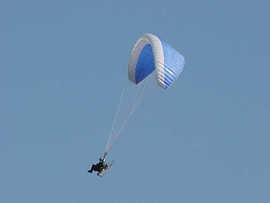
Motoring the Dragon
I found that the wing had very good dampening in
thermals, with very little tendency to surge forward or back when
flying in thermic conditions. When entering a strong thermal, the
glider seems to ‘bite’ into the thermal instead of slowing down
and hanging back, like my Atlas did. When I first flew it in thermal
conditions, it seemed to need more surge control than the Atlas, but
then I realized that this was because I was over correcting my
inputs. I would speed the wing up, expecting the surge backwards
when entering the thermal when it was unnecessary/ Not that you
shouldn’t be checking the surge of the glider, but my initial
belief that it was a ‘busy’ a glider was actually due to pilot
error. My overall impression is that this glider ‘slices’
through the air, even rough air, instead of getting bounced around
by it. Turns are quick and the wing is very agile, but it does not
accelerate into the turns. While thermaling, I found that I did not
have to rely on use of the outer brake to keep my bank angle
constant.
Like most of the newer crop if DHV-1-2 wings, the
Dragon flies better when it is flown at the top of its weight range.
When motoring the Dragon, I am actually 12 lbs over the placarded
top weight for the wing. Even with the wing overloaded, the sink
rate is amazingly low. After launching with the motor to gain
altitude and then shutting down, I recorded at trim speed at 37km/hr
and a top speed (full speed bar) of 53km/hr. This is flying the wing
fully loaded over its placarded weight range. I have not timed the
speeds without the added weight of the motor.
Big Ears: Pulling big ears is a simple matter
of grabbing the outer A risers and tugging and I have no problem
reaching the split A’s even when flying with a motor. The ears pop
out once you let go of the A's.
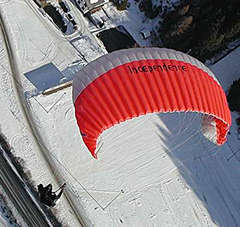
Asymmetric Tucks: I tested asymmetric folds
up to 40% of the wings span. The wing showed little turning tendency
up to 30% and after that, could easily be flow straight with
opposite weight shift or outside brake while holding the tuck.
Frontal Tucks: Frontals with this wing are very easily
tested compared to my previous wing, an Edel Atlas. Since the wing
is so fast, pulling the A’s down symmetrically quickly decreases
the Angle of Attack until the wing’s leading edge folds under.
Recovery happens immediately; as the wing fills from the center, out
to the tips. Each frontal was recovered with less than 50-60ft of
altitude loss.
Full Stall: No way! I'm waaay too chicken to try this
without professional coaching over the water. :)
Spiral Dives: Spirals initiate easily, with constant
pulling of one brake. The wing does not show a tendency to lock into
a spiral, flattening out slowly as you decrease inside brake
pressure. The speed at which a spiral develops is very fast and
beginner should be cautioned.
Landings: The slow speed capabilities of this
wing make it very simple to land. Even if you come in at min sink,
slowly bleeding of speed, the glider still retains enough energy for
a nice, soft flared landing.
Other Goodies: The wing comes with the
standard paraglider transport bag. It’s a VERY large bag, simply
constructed that will easily hold a full harness and back
protection, the wing, and any other equipment the pilot wants to
stuff into it. In addition to the transport back, the wing also
comes with a blaze orange stuff sack, and a similar blaze orange
riser back – body imprinted with the independence logo and tag
line of “Gliders for Real Pilots.” Expect to take lots of grief
from the guys on the hill or the flying field about this tag line,
which is also printed on the wing tips.
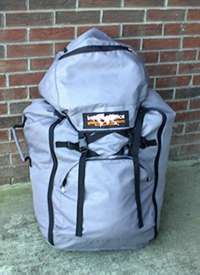
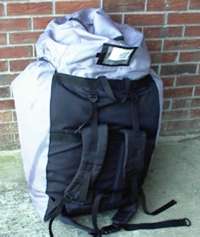
The cargo bag
supplied with the Dragon
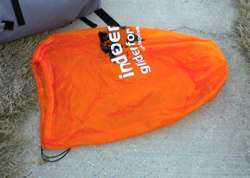
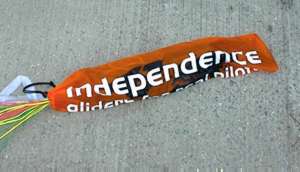
The glider stuff sack and riser bag - no confusing your glider with
your buddies while its in this bag.
Summary:
In summary, this is a very good 'step-up' wing for an
intermediate pilot. Its agility and great gliding ability are
perfect for thermaling, as well as motorized flight. The wide weight
range allows pilots to purchase one wing for both powered and
unpowered flight. Its fun to fly, performs well, and is fairly safe
wing. I would suggest that perspective pilots take a close look at
the DHV report. The Dragon is a 1-2 rated wing, but it gets lots
more '1-2' ratings than '1' ratings. I'm enjoying the hell out of
mine, and I whole heartedly recommend it to other pilots, both
powered and unpowered.
Special thanks to Greg McNair for most of the photos and videos
on this page.
Quotes from Other Pilots:



